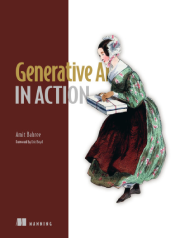
عنوان:
Generative AI in Action Edition: 1
نویسنده:
Amit Bahree
انتشارات:
Manning City: Shelter Island, NY
تاریخ انتشار:
2024
حجم:
6.2MB
معرفی کتاب:" هوش مصنوعی مولد در عمل – ویرایش اول "
کتاب «هوش مصنوعی مولد در عمل» نوشتهی Amit Bahree به شما نشان میدهد که چگونه از هوش مصنوعی مولد (Generative AI) برای متحولسازی فرایندهای کسبوکار خود استفاده کنید. از تولید متن، تصویر و کد گرفته تا ارتقای بهرهوری تیمها، این کتاب یک راهنمای عملی برای یکپارچهسازی AI در عملیات روزمرهی سازمانهاست.
چه خواهید آموخت:
- مروری کاربردی بر موارد استفادهی واقعی از هوش مصنوعی مولد
- الگوهای معماری، راهنمای پیادهسازی و یکپارچهسازی در مقیاس سازمانی
- کار با تکنیکهای نوین مانند RAG، مهندسی اعلان (Prompt Engineering) و چندوجهیبودن (Multi-Modality)
- درک چالشهایی مانند توهمزایی (Hallucination)، حملات Jailbreak و ملاحظات ایمنی
- چگونگی تلفیق AI در استراتژیهای فناوری اطلاعات و تحول دیجیتال در سازمان
ویژگیهای کتاب:
این کتاب با پرهیز از اغراقهای رایج پیرامون AI، تجربهی واقعی نویسنده از پروژههای پیشرفته در Microsoft را در اختیار شما میگذارد. معماریهای پیشنهادی، نمونههای موردی ملموس و توصیههای عملی، ابزارهایی هستند که شما را برای پیادهسازی موفق هوش مصنوعی مولد در سازمان آماده میکنند.
مناسب برای:
معماران نرمافزار، توسعهدهندگان ارشد، مدیران فناوری و تمامی کسانی که به دنبال کاربرد عملی و سازمانی از Generative AI هستند.
درباره نویسنده:
Amit Bahree مدیر ارشد فنی در شرکت Microsoft است. او در تیم مهندسی Azure AI فعالیت دارد و مسئول توسعهی نسل آیندهی خدمات هوش مصنوعی برای میلیونها کاربر است. تجربیات او در زمینهی مهندسی راهکارهای سفارشی سازمانی با استفاده از AI، پایهگذار مطالب این کتاب کاربردی است.
فهرست مطالب
- Foreword>
- Preface>
- Acknowledgments>
- About this Book>
- About the Author>
- About the Cover Illustration>
- Part 1: Foundations of Generative AI
- 1. Introduction to Generative AI
- 1.1 What is this book about?
- 1.2 What is generative AI?
- 1.3 What can we generate?
- 1.4 Enterprise use cases
- 1.5 When not to use generative AI
- 1.6 How is generative AI different from traditional AI?
- 1.7 What approach should enterprises take?
- 1.8 Architecture considerations
- 1.9 So your enterprise wants to use generative AI. Now what?
- Summary
- 2. Introduction to Large Language Models
- 2.1 Overview of foundational models
- 2.2 Overview of LLMs
- 2.3 Transformer architecture
- 2.4 Training cutoff
- 2.5 Types of LLMs
- 2.6 Small language models
- 2.7 Open source vs. commercial LLMs
- 2.8 Key concepts of LLMs
- Summary
- 3. Working Through an API: Generating Text
- 3.1 Model categories
- 3.2 Completion API
- 3.3 Advanced completion API options
- 3.4 Chat completion API
- Summary
- 4. From Pixels to Pictures: Generating Images
- 4.1 Vision models
- 4.2 Image generation with Stable Diffusion
- 4.3 Image generation with other providers
- 4.4 Editing and enhancing images using Stable Diffusion
- Summary
- 5. What Else Can AI Generate?
- 5.1 Code generation
- 5.2 Additional code-related tasks
- 5.3 Other code generation tools
- 5.4 Video generation
- 5.5 Audio and music generation
- Summary
- Part 2: Advanced Techniques and Applications
- 6. Guide to Prompt Engineering
- 6.1 What is prompt engineering?
- 6.2 The basics of prompt engineering
- 6.3 In-context learning and prompting
- 6.4 Prompt engineering techniques
- 6.5 Image prompting
- 6.6 Prompt injection
- 6.7 Prompt engineering challenges
- 6.8 Best practices
- Summary
- 7. Retrieval-Augmented Generation: The Secret Weapon
- 7.1 What is RAG?
- 7.2 RAG benefits
- 7.3 RAG architecture
- 7.4 Retriever system
- 7.5 Understanding vector databases
- 7.6 RAG challenges
- 7.7 Overcoming challenges for chunking
- 7.8 Chunking PDFs
- Summary
- 8. Chatting with Your Data
- 8.1 Advantages to enterprises using their data
- 8.2 Using a vector database
- 8.3 Planning for retrieving the information
- 8.4 Retrieving the data
- 8.5 Search using Redis
- 8.6 An end-to-end chat implementation powered by RAG
- 8.7 Using Azure OpenAI on your data
- 8.8 Benefits of bringing your data using RAG
- Summary
- 9. Tailoring Models with Model Adaptation and Fine-Tuning
- 9.1 What is model adaptation?
- 9.2 When to fine-tune an LLM
- 9.3 Fine-tuning OpenAI models
- 9.4 Deployment of a fine-tuned model
- 9.5 Training an LLM
- 9.6 Model adaptation techniques
- 9.7 RLHF overview
- Summary
- Part 3: Deployment and Ethical Considerations
- 10. Application Architecture for Generative AI Apps
- 10.1 Generative AI: Application architecture
- 10.2 Generative AI: Application stack
- 10.3 Orchestration layer
- 10.4 Grounding layer
- 10.5 Model layer
- 10.6 Response filtering
- Summary
- 11. Scaling Up: Best Practices for Production Deployment
- 11.1 Challenges for production deployments
- 11.2 Deployment options
- 11.3 Managed LLMs via API
- 11.4 Best practices for production deployment
- 11.5 GenAI operational considerations
- 11.6 LLMOps and MLOps
- 11.7 Checklist for production deployment
- Summary
- 12. Evaluations and Benchmarks
- 12.1 LLM evaluations
- 12.2 Traditional evaluation metrics
- 12.3 LLM task-specific benchmarks
- 12.4 New evaluation benchmarks
- 12.5 Human evaluation
- Summary
- 13. Guide to Ethical GenAI: Principles, Practices, and Pitfalls
- 13.1 GenAI risks
- 13.2 Understanding GenAI attacks
- 13.3 A responsible AI lifecycle
- 13.4 Red-teaming
- 13.5 Content safety
- Summary
- Appendix A. The Book’s GitHub Repository
- Appendix B. Responsible AI Tools
- References
- Index
- Back Cover
مشخصات
نام کتاب
Generative AI in Action Edition: 1
نویسنده
Amit Bahree
انتشارات
Manning City: Shelter Island, NY
تاریخ انتشار
2024
ISBN
9781633438880
تعداد صفحات
466
زبان
انگلیسی
فرمت
حجم
6.2MB
موضوع
Artificial Intelligence
